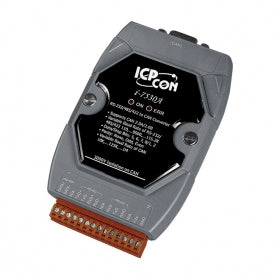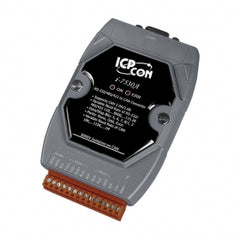

I-7530A RS232/422/485 to CAN Bus Converter
- £183.00
- £183.00
- (-0%)
- Unit price
- per
The I-7530A RS232,RS422 or RS485 to CAN Bus converter makes it possible to connect a host PC/HMI Display into a CAN Bus Network. Similarly it can also allow standard RS232 devices to be connected to a CAN Bus Network.
Subtotal:
£183.00
Couldn't load pickup availability
Free Shipping
Free standard shipping on orders over £500
Free Returns
30 Day Money Back Guarantee
Description
xThe I-7530A RS232,RS422 or RS485 to CAN Bus converter makes it possible to connect a host PC/HMI Display into a CAN Bus Network. Similarly it can also allow standard RS232 devices to be connected to a CAN Bus Network.
The PC can be the CAN host, monitor or HMI to access/control the CAN device through the CAN network via the I-7530 Converter. The programmable RS-232 device (For example: I-8411/I-8431/I-8811/I-8831/W-8341/W-8741 embedded controller) can use the serial port to connect to the CAN network via the I-7530 module.
The I-7530A is designed to unleash the power of CAN bus via Serial communication method. It accurately converts messages between CAN and RS-232 networks. This module allows you to communicate with CAN devices easily from any PC or from any device with a Serial interface.
Features
x 3000V isolation on CAN side
The CAN port of I-7530A has 3000V isolation. This isolation can protect the local RS-232/485/422 devices from damaging signals coming from the CAN network.
Watchdog inside
The I-7530A Watchdog has a hardware reset circuit to monitor the I-7530A's operational status. When working in harsh or noisy environments, the I-7530A may be affected by the external signal. The circuit will help the I-7530A to continue to operate.
Power and Error indicator display
There are two indicators on the I-7530A.The power indicator can help the user to check whether the I-7530A is in standby or is transmitting/receiving messages. The Error indicator will be turned on when errors occur on the I-7530A.
- Compatible with CAN specification 2.0A and B
- Fully compatible with ISO 11898-2 standard
- Supports various bauds from 10K bps to 1M bps
- Jumper for 120 Ω terminator resistor
- Software configurable CAN and RS-232 /422/485 communication parameters
- Power, data flow and error indicator for CAN and RS-232/422/485
- Watchdog inside
- Provides the transparent communication between the RS-232/485/422 devices via CAN bus
- Enables different RS-232/485/422 devices into an individual group in CAN bus network.
(Full-duplex communication mode of RS-232/422 devices is not supported)
Software Utility Features
- CAN bus Baud rate configuration
- CAN acceptance filter configuration
- CAN 2.0A or 2.0B specific selection
- RS-232/485/422 Baud rate and data bit setting
- RS-232/485/422 responded selection
- Easy test to transmit/receive CAN messages
- Setting for I-7530A communication mode (normal mode or pair connection mode)
Specifications
x- Microprocessor inside with 20MHz
- CAN Port channels : 1
- CAN interface connector: ISO/IS 11898-2, D-Sub 9-pin
- Philips 82C250 CAN transceiver
- CAN Baud Rates: 10k, 20k, 50k, 100k, 125k, 250k, 500, 800k, 1Mbps
- Protection: 3000Vdc power protection on CAN side, 2500Vrms photo-couple isolation on CAN bus
- Termination Resistor: 120Ω, selectable by jumper
- Supports: CAN 2.0A, 2.0B
- Pin-out: C.I.A. DS-102 (CAN_H=7, CAN_L=2, GND=3)
- Receive Buffer: 1000 data frames
Serial Interface
- Connector: 14-pin terminal connector
- Baud rates: 110, 150, 300, 600, 1200, 4800, 9600, 19200, 38400, 57600, 115200 bps
- Data bits: 5,6,7,8
- Parity/stop bits: Odd, Even, No Parity; 1,2 stop bits
- Receive Buffer: 900 data frames
Others
- Power Consumption: 1W
- Power Requirement: Unregulated +10Vdc ~ +30Vdc.
Power reverse protection
Over-voltage brown-out protection - LED's: ON LED = Power and Data Flow; ERR LED = Error
- Operating Temperature: -25°C to +75°C
- Storage Temperature: -40°C to +80°C
- Humidity: 5~95% non-condensing
- Dimensions: 118 x 72 x 33mm (HxWxD)
Applications
xRelated Products
Example product title
- £183.00
- £183.00
- (-0%)
- Unit price
- per
Example product title
- £183.00
- £183.00
- (-0%)
- Unit price
- per
Example product title
- £183.00
- £183.00
- (-0%)
- Unit price
- per
Example product title
- £183.00
- £183.00
- (-0%)
- Unit price
- per
Example product title
- £183.00
- £183.00
- (-0%)
- Unit price
- per
Example product title
- £183.00
- £183.00
- (-0%)
- Unit price
- per
Example product title
- £183.00
- £183.00
- (-0%)
- Unit price
- per
Example product title
- £183.00
- £183.00
- (-0%)
- Unit price
- per
Example product title
- £183.00
- £183.00
- (-0%)
- Unit price
- per
Example product title
- £183.00
- £183.00
- (-0%)
- Unit price
- per
Recently Viewed Products
Example product title
- £183.00
- £183.00
- (-0%)
- Unit price
- per
Example product title
- £183.00
- £183.00
- (-0%)
- Unit price
- per
Example product title
- £183.00
- £183.00
- (-0%)
- Unit price
- per
Example product title
- £183.00
- £183.00
- (-0%)
- Unit price
- per
Example product title
- £183.00
- £183.00
- (-0%)
- Unit price
- per
Example product title
- £183.00
- £183.00
- (-0%)
- Unit price
- per
Example product title
- £183.00
- £183.00
- (-0%)
- Unit price
- per
Example product title
- £183.00
- £183.00
- (-0%)
- Unit price
- per
Example product title
- £183.00
- £183.00
- (-0%)
- Unit price
- per
Example product title
- £183.00
- £183.00
- (-0%)
- Unit price
- per
- Choosing a selection results in a full page refresh.

